– is not at all the last component of safe movement. That is why they must be in proper technical condition. And also (along with the technical aspect) wheel disks carry out design and decorative functions. Wheels in every car are an important component, so you need to be able to monitor the cosmetic and technical aspects of wheels and tires.
Currently, there is a wide range of tire and wheel care products, which is why it is extremely difficult to understand this variety, but more is possible. Moreover, taking into account the variety of materials (steel, forging, casting) from which discs are made, it is extremely necessary to know minimal information about their maintenance and the process of giving the proper aesthetic condition.
Wheel care
Wheels require proper care, it doesn’t matter whether it’s stamping, casting or an expensive forged disc.
The most important thing to monitor is good condition. A dirty or slightly rusted wheel is common, but one that is warped or cracked from an impact can be a real hazard to your vehicle's occupants.
The fact is that while driving, the deck discs experience significant stress, from which they can collapse, or, even worse, the tires can begin to be removed from the destroyed discs and lead to tragedy. To prevent tragic consequences, you should follow simple rules for maintaining wheels in proper condition.
We follow the geometry
Every six months, when changing winter tires to summer tires (or vice versa), it is necessary to check the shape of the discs for deviations from the original shape. You can check the geometry on a balancing machine using a control ruler (only check in this case without a tire). In the absence of a special machine, the geometry can be checked “by eye”.
In this way, the circumference of the disk is checked, that is, whether the evenness of the circle is maintained by looking at it from the side while rotating. In the same way, you can check the absence of “eights”, i.e. Check the edges horizontally for radial runout. Traveling in a car with wheels of modified geometry is strictly prohibited. You can find out whether it is possible to repair minor damage or whether repairs are impractical, from repair specialists.
We eliminate chips and dents
The quality of roads is often poor and weather lead to dents on steel wheels and chips on cast and forged wheels. The appearance of these damages can be detected visually or during the next tire fitting.
Steel stampings are subject to restoration by “rolling” on a special machine, and casting repairs are carried out on special equipment by argon-arc welding, followed by grooving, rolling and grinding on a machine. Repairing forged wheels is similar to work on restoring cast wheels (only heated to a temperature of 200 degrees in a special furnace).
Anti-corrosion treatment and painting
The appearance of rust on steel wheels is not uncommon. Rust not only spoils appearance: First of all, it can disrupt the integrity and weaken the structure of the disk. Stamped discs are the most susceptible to the appearance of rust spots: they should be monitored most closely.
You can get rid of rust stains using anti-corrosion agents. Sanding with a wire brush followed by priming and painting is also effective. More expensive, but effective way eliminating rust along with old paint - sandblasting. After this treatment, the discs can be painted with regular metal enamel and powder paint.
The enamel-powder painting technology requires special equipment, but the resulting coating is more resistant to atmospheric influences, as well as mechanical damage. Cast and forged wheels are painted, polished and coated with a special varnish after repair.
Washing and cleaning
Washing wheels is more a cosmetic procedure than a technical one. But here we should pay attention Special attention cleaning not the outer part of the disk, but the inner one, since it is in this place that dirt and snow can stick, leading to the steering wheel beating.
Wheel operation
Wheels made from different materials, must also be operated differently.
Operation of steel (stamped) disks
Such discs are the cheapest, and therefore the most fragile. In addition, they are also noticeably heavier than others. A noticeable advantage of steel wheels is their softness. This means that when the car moves over potholes and uneven surfaces, the discs absorb some of the impacts and thereby absorb the impacts. And dirt and snow that stick well to steel wheels impair the car's handling. That is why steel wheels require the most and early care.
Operation of light alloy (cast) wheels
Alloy wheels are lighter than steel wheels, they become less dirty, and the cleaning process is greatly simplified by powder coating and varnishing. In the same time alloy wheels are superior in hardness to steel, but this also means that there is a more “hard” transmission of shocks and loads from the wheels to other elements of the car’s suspension. Alloy wheels are also more beautiful than steel ones: they do not require the installation of plastic decorative caps on top.
Operation of forged ultra-light (forged) wheels
Forged wheels are the lightest, strongest, and stiffest wheel structure available for automobiles. Of course, the set of specified characteristics is reflected in the extremely expensive price. But the purchase and installation of forged wheels will allow you and your car to increase speed performance with reduced fuel consumption, as well as operate the car in extreme conditions with the highest degree of safety.
Storage
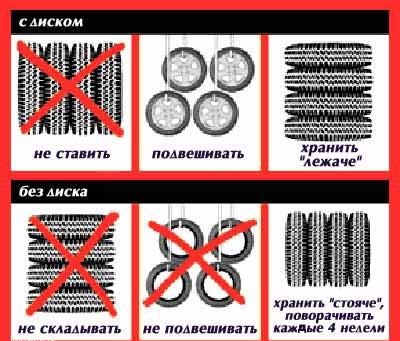
Here's how to properly store tires. Click on photo to enlarge.
Car rims can be stored separately from tires, or together with tires.
The assembled system simplifies the storage process and seasonal wheel changes.
You should also know that it is better to store tires without disks in a vertical position, periodically changing their fulcrum point, and the assembled system should be stored in a horizontal position (can be on top of each other, but the tire pressure should not be higher than 1 atm).
Wheels should be kept clean. Before storage, they can also be coated with a preservative lubricant or composition.
The best place to store tires and wheels is in a place that is protected from ingress. sun rays a room, preferably with an air temperature ranging from -30 to +30 degrees and a humidity of 50-80%.
Range of products for cosmetic wheel care
To care for wheels and tires, as well as to protect them from road dirt, bitumen and sudden temperature changes, you can find a number of effective products on the chemical market:
- Sprays and liquids for dissolving and removing various types of contaminants from wheels;
- Polishes, thanks to their protective layer, they are able to repel brake dust and salt mixture;
- Specially designed brushes and sponges for cleaning discs allow you to clean even the most hidden cavities and corners;
- Rubber conditioners and restorative agents add shine and a pleasant appearance to tires, and also prevent scuffs and microcracks.
And some more practical tips:
When parking a car, you should not allow the wheels and the curb to come into contact, so as not to subject them to unnecessary mechanical stress.
Before operating the car, it is better to protect the wheels and tires using special means.
It is better to clean wheels and tires with high pressure when using special brushes; without brushes it is not recommended to use high blood pressure, since it can damage the integrity of the rubber and the protective varnish (chemical cleaners designed for this purpose can also be used during the cleaning process).
Treatment with anti-aggressive agents will help keep your wheels clean. external environment polishes.
Compliance with simple rules of operation, care of wheels and their proper storage will allow you to extend the life of the wheel system and the car as a whole. But the most important thing is that by purchasing high-quality components for your car, you increase your safety.
Discs, as one of the car parts located close to the road surface, are subject to impacts that lead to the formation of defects and corrosion. This article discusses why corrosion occurs on disks. various types and how to remove it.
Causes of rust formation on discs
The main reason leading to corrosion of any metal parts is considered to be chemical exposure water and chemically active substances. Since the discs are in close proximity to the road surface, they come into contact with water, salt and other chemicals, used in winter period as anti-ice agents.
Rust spreads to metal parts much faster if there are defects on the protective coating. Discs are often damaged, for example, when parking. The protective coating, which can be provided for discs with paint and varnish material, is torn off, exposing the metal to the influence of the above factors. And rust, as we know, attacks unprotected areas much faster.
Disk types
The rust resistance of these parts is largely determined by their design. This is due to the fact that discs of different configurations are made from different materials using various technologies processing. And they are classified into stamped, cast and forged.
Stamped discs are the most common, due to their low cost. Therefore, the most accessible, inexpensive car models and trim levels are equipped with such parts. The low cost of these parts is due to the simplicity of their production technology and the low price of raw materials. They are made from straight sheets of steel. The disc consists of two connected parts, represented by a rim and a circle.
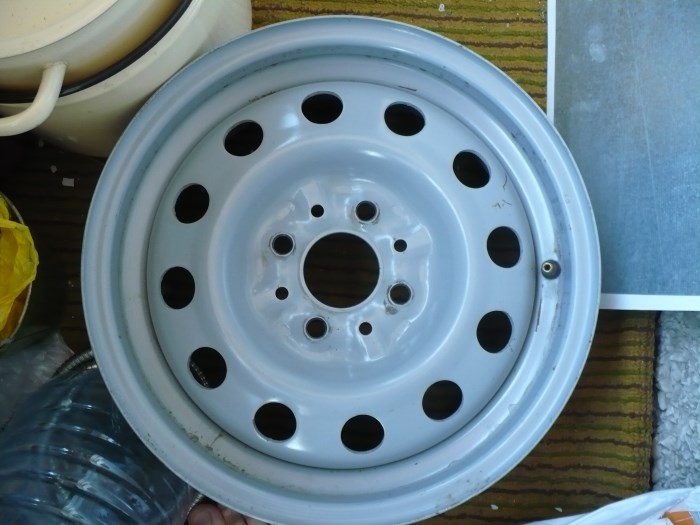
In terms of corrosion protection, stamped wheels are the least attractive. This is explained, first of all, by the low quality of painting. Therefore, the paint and varnish material is quickly destroyed under the influence of the factors mentioned above.
The most reliable and durable coatings for disks of this type are powder enamels. This is explained by the fact that they are applied under the influence electric current. That's why this material fits tightly to the surface and maintains its integrity for a long time.
In addition, there are unpainted versions of stamped discs. To preserve them from rust, they should be painted annually.
Alloy wheels, as the name suggests, are produced by casting. This technology consists in the fact that the initial melt is poured into a mold (applying pressure in the injection molding method or without it in gravity casting). After hardening, the workpiece is subjected to hardening, which consists of thermal exposure, and is processed mechanically. Finally, paint and varnish material is applied and protective covering.
As starting materials for production alloy wheels magnesium and aluminum alloys. From the point of view of corrosion protection, cast wheels made from the first material are less preferable. However, in any case, both magnesium and aluminum cast models resist rust much better than their stamped counterparts. Therefore, corrosion on disks of this type is very rare. And yet, the reagents used as deicing agents in winter quickly destroy the protective coating of alloy wheels.
Forged wheels are produced using industrial stamping technology and then hardened. The starting materials for the manufacture of such parts are the same alloys as for cast wheels. Therefore, these types of discs are similar in corrosion resistance.
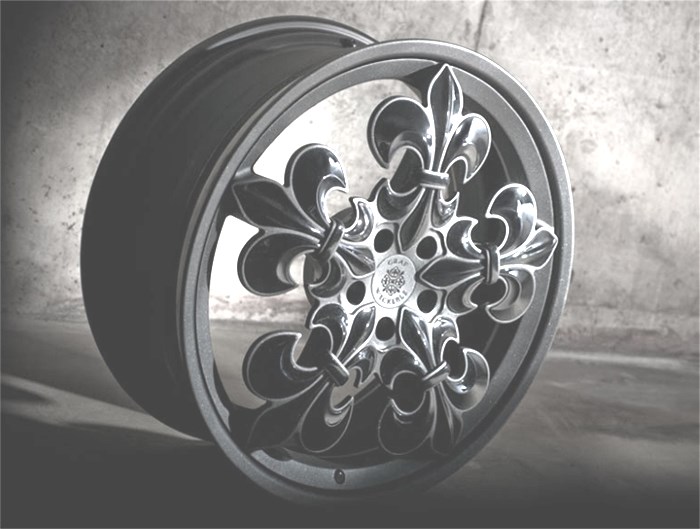
Treating stamped wheels against rust
Painting is considered the main method of protecting new stamped wheels from corrosion. If these parts are already affected by corrosion, it is necessary to first remove all existing foci.
There are several painting methods for stamped wheels. Professional technologies, for example, powder painting, involve the use of special powder and phosphorus. For professional painting work, special equipment is used. In view of this, the painting methods under consideration are not feasible in domestic conditions, and they are used in car services and paint shops. However, there are also methods for painting discs that are suitable for non-professional performers working in domestic conditions. Below we consider the most simple technology, which is attractive because it is accessible to a wide range of users. Firstly, this method does not require special knowledge and skills. Secondly, the work can be completed fairly quickly. Thirdly, the materials and equipment used in this technology are inexpensive.
Painting wheels includes the following steps:
- preparation of materials and equipment necessary for work;
- cleaning disks from dirt;
- diagnostics;
- recovery;
- grinding;
- primer;
- painting;
- applying varnish.
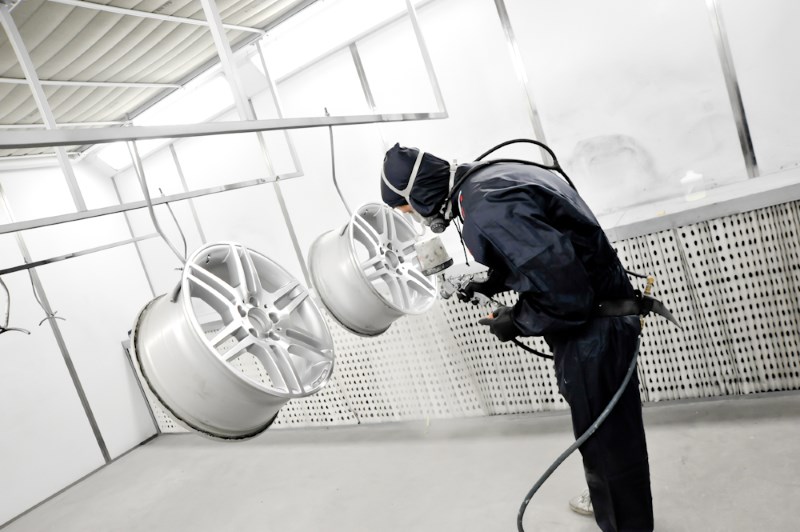
To paint wheels at home you will need following materials and tools:
- spray gun;
- primer;
- acrylic paint;
- a drill equipped with an attachment for metal brushes;
- sandpaper;
- solvent;
- tape for painting;
- facilities personal protection, represented by a mask and gloves.
Before starting work, the disk should be removed from the car and the tire should be removed from it. It is also advisable to hang it, for example, with wire. This greatly simplifies access to all surfaces of the part. Removal of contaminants from stamped discs is carried out by washing using conventional detergents. Particularly difficult contaminants are removed chemicals, such as solvents. After drying, carefully inspect the disc to detect any defects.
If there is damage on the part, it must be removed. Dents are straightened out, deep scratches grind with a file, pockets of corrosion on the disks are eliminated by grinding or chemical means. Rust removal should be considered in more detail.
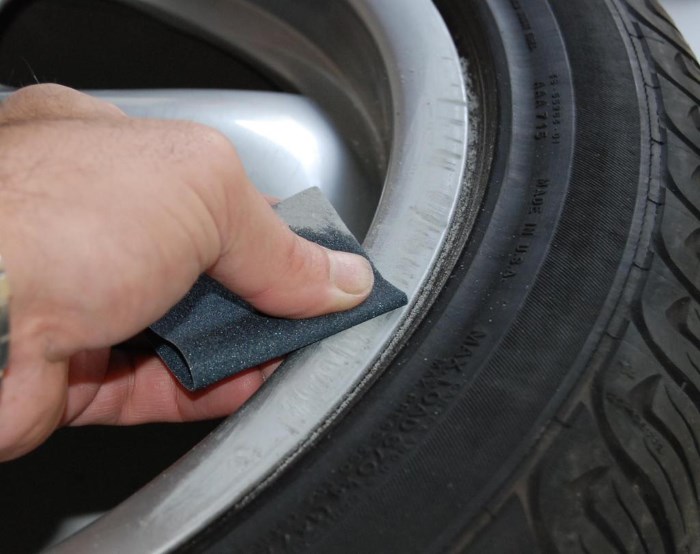
For this work you will need the following tools and materials:
- sandpaper with a grain size of P120 - P60 (the amount of grain required in each specific case is determined by the depth of corrosion of the metal);
- rags;
- solvent;
- rust converter into soil.
Treatment of rust-affected disk fragments begins with grinding. At this stage, loose pieces of corrosion called flakes are removed. The treatment is completed upon reaching a flat surface covered with a thin layer of corrosion. Then the polished particles of material are removed from the disk with a rag. After this, the surface to be treated is degreased.
After the solvent has dried, the entire disk is treated with a corrosion converter. Depending on the condition of the part, the treatment is repeated 1 - 2 more times at intervals of 3 - 5 minutes. After some time, the converter will begin to operate, as evidenced by the blackening of the corroded areas.
To completely transform the rust into soil, you need to leave the disc for a day. This way you can clean even deeply corroded parts. Unpainted disk fragments are covered with masking tape.
The disc is polished using abrasive materials in the form of sandpaper or a drill with metal brushes. This removes the old paintwork and minor defects. During operation, the part is doused with water several times to remove polished particles. Upon completion of grinding, the disc is completely washed and degreased with a solvent. The primer is applied with a paint sprayer in 2-3 layers. After completing each layer, take a short break to dry. After applying and drying all layers of primer, sanding is carried out sandpaper to level the surface.
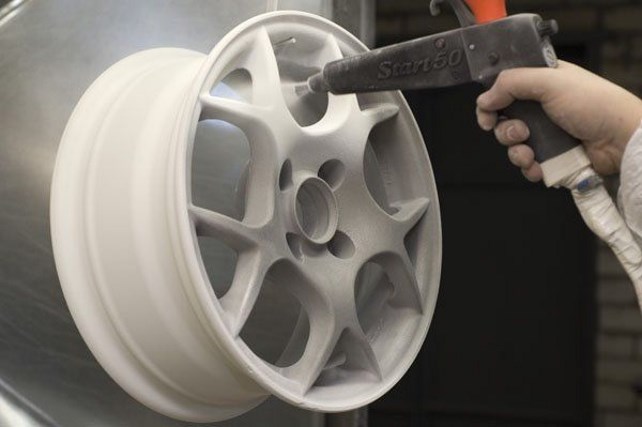
The considered stage of painting disks is not necessary, but desirable, since the primer increases anti-corrosion resistance and increases the adhesion of the paint to the surface several times.
Before use, the paint and varnish material must be thoroughly stirred. Then it is sprayed with a spray gun or spray can. In this case, you should keep the tool 40-50 cm from the surface being treated. The paint is also applied in 2-3 layers with breaks after each of them for drying. Once the paint has dried, you can coat the disc with varnish. A disc treated in this way receives corrosion protection for several years. Moreover, if the work is performed in accordance with all the rules, then the quality of the created paint coating is not inferior to professionally carried out painting.
Treatment of cast and forged wheels against corrosion
It should be noted that for stamped disks the most simple methods processing. This is explained by their low cost, and therefore processing using complex, expensive technologies is impractical. And if in some cases these parts are easier to replace than to restore, then with cast and especially forged wheels everything is different due to the high cost, and when repairing them, more expensive and complex technologies. For example, professional cleaning of such parts, in addition to abrasive and chemical processing, includes etching and phosphating.
The first method consists of treating parts with solutions of hydrochloric, sulfuric, phosphoric, nitric acids or caustic soda. This allows you to eliminate oxides and rust. Phosphating refers to the treatment of steel parts with iron phosphate, aluminum parts with chromium, as well as manganese phosphate and chromic anhydride. This method increases the adhesion of the paint and varnish material to the surface.
In addition, powder coating technology is often used for light alloy wheels. Its essence is the polymerization of the coloring layer under thermal influence. Paint material applied by dry spraying.
Work is carried out in paint booth using a spray applicator. The charged powder is held on the neutral surface by electrostatic attraction. Upon completion of painting, the disc is melted in a polymerization chamber at a temperature of 190-220°C. It should be noted that painting using this technology is not feasible in domestic conditions. However, light alloy wheels can also be coated acrylic paint, like stamped ones.
If the rims of your car are covered with rust and have lost their presentation, they can be restored quite simply. You don't even have to disassemble the wheel to do this.
Step 1. To begin, remove the rims and tires from the car. It is not necessary to disassemble the wheels, but if you want to completely renew the wheels, it is better to do so. The main thing to remember is that removing tires from rims is much easier than putting them on. If you do not have experience in tire fitting, it is better to use the services of a workshop of the appropriate profile.
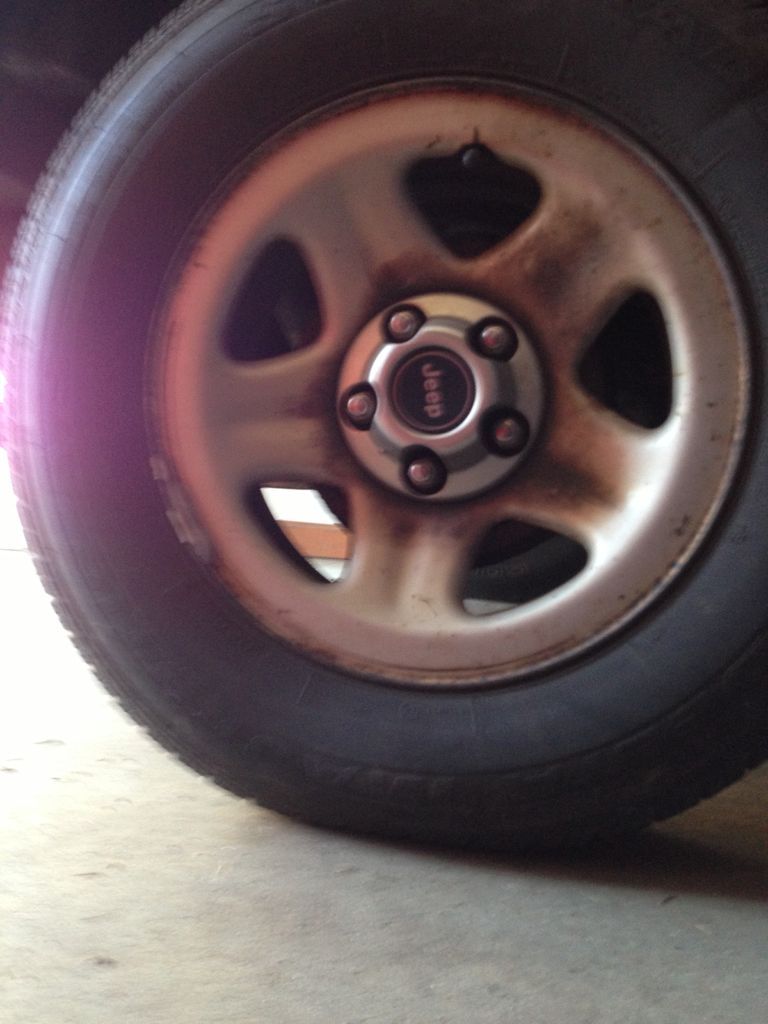 Step 2. If you have a decorative cap installed in the center of the disk, you need to remove it. If you are not going to disassemble the wheel, now you need to protect the rubber. To do this, cover it with masking tape on both sides. It is also worth covering with tape the brand of the car/wheel, if there is one (like the Jeep inscription in the photo), and the nipple.
Step 2. If you have a decorative cap installed in the center of the disk, you need to remove it. If you are not going to disassemble the wheel, now you need to protect the rubber. To do this, cover it with masking tape on both sides. It is also worth covering with tape the brand of the car/wheel, if there is one (like the Jeep inscription in the photo), and the nipple.
Step 3. Remove old paint, rust and dirt grinder with wire attachment. This stage will take some time, but the result will be worth it. Apply automotive primer to the cleaned disc. It is best to use a spray bottle for this purpose, so the paint layer will be even. When coating, follow the instructions on the primer package. It is better to apply several thin layers. I applied three coats, when I was done with one coat on the last wheel, the first wheel was already ready for the next coat. It is very important that the primer gets into all places, this will protect the disc from rust and paint peeling. You should end up with something like this:
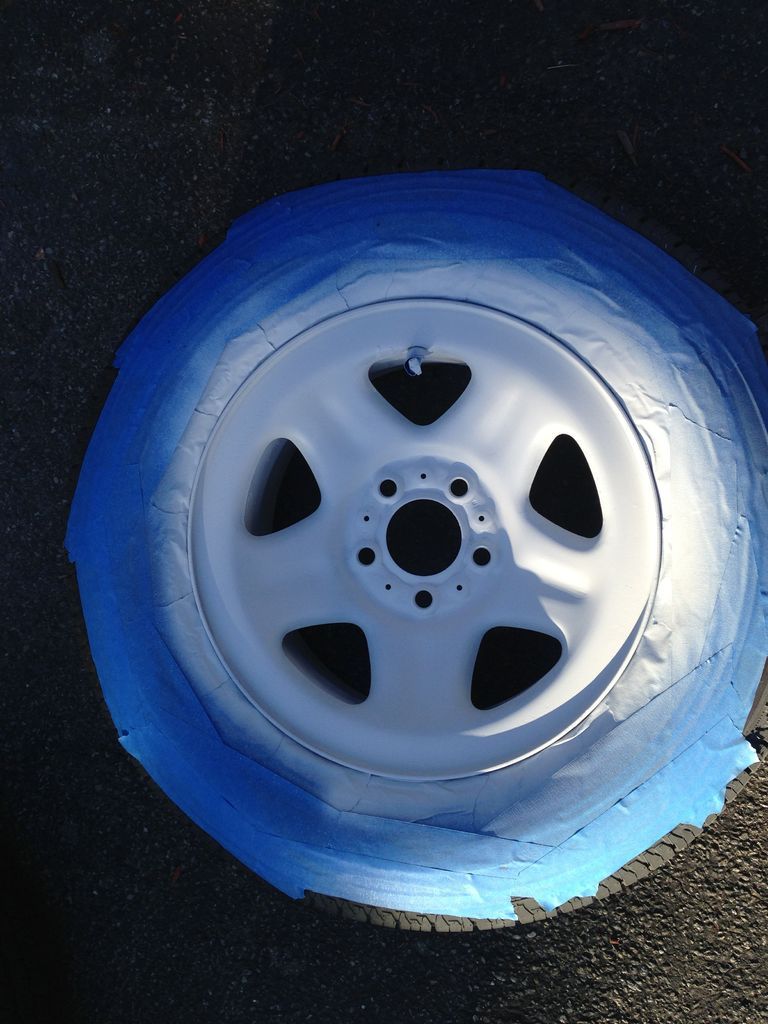 Step 4. This is the most interesting step - applying the paint. I used spray paint, it goes well on any surface, and the choice of colors is amazing. True, I settled on classic black. Apply paint thin layers in accordance with the instructions on the can. I applied four coats, you need to wait for the previous one to dry before applying the next one. After applying the last layer, you need to let the paint dry completely, this will take 24 hours. It took me three cans of spray paint to make four discs.
Step 4. This is the most interesting step - applying the paint. I used spray paint, it goes well on any surface, and the choice of colors is amazing. True, I settled on classic black. Apply paint thin layers in accordance with the instructions on the can. I applied four coats, you need to wait for the previous one to dry before applying the next one. After applying the last layer, you need to let the paint dry completely, this will take 24 hours. It took me three cans of spray paint to make four discs.
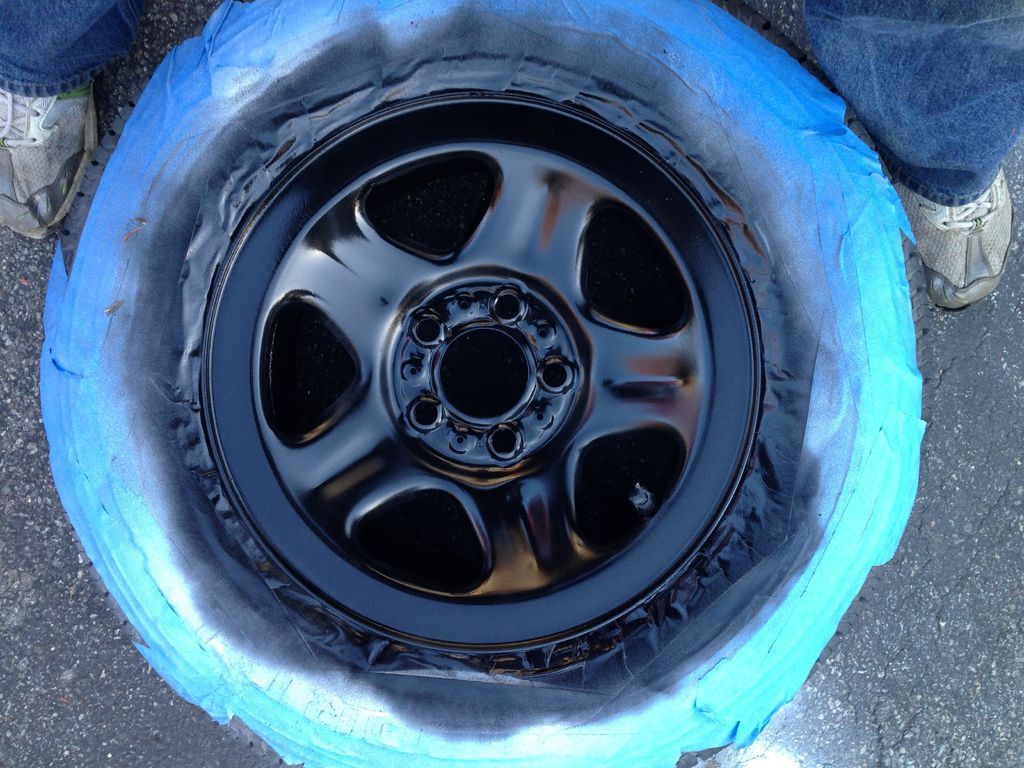
Step 5. Now paint the hubcaps using the same procedure, first apply primer, then paint. If the caps are plastic, there is no need to prime them. We also apply 4 layers of paint and let dry for 24 hours.
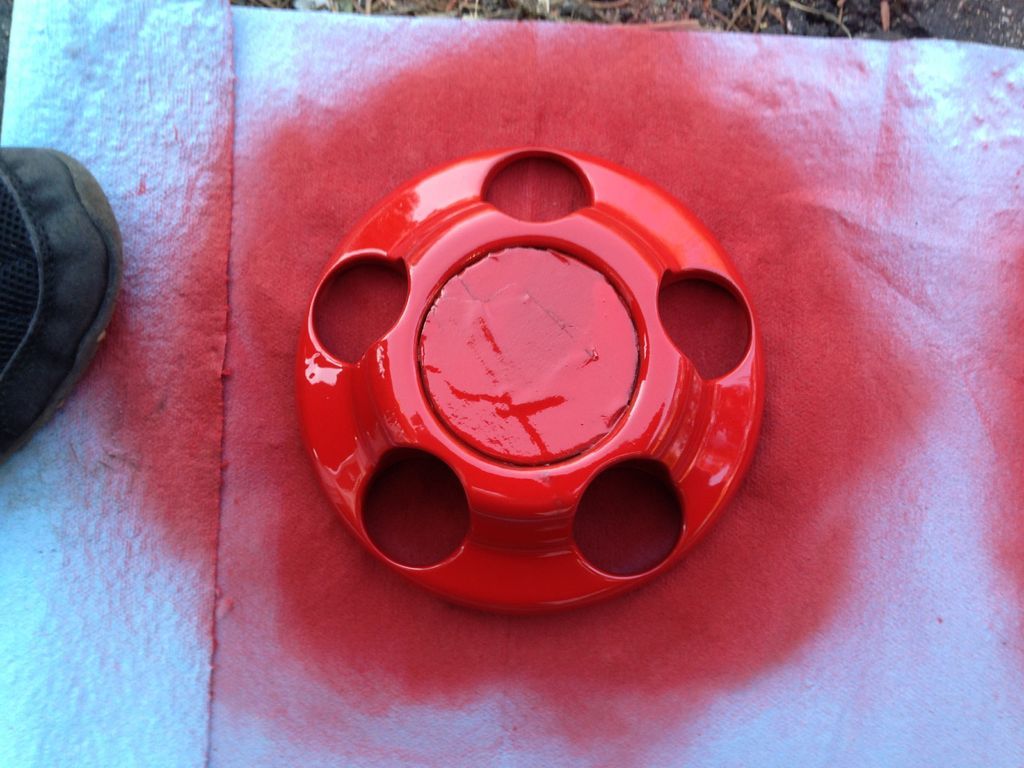
Step 6. Now you need to protect the coating rims and caps. For this I used clear car varnish. Apply the polish according to the instructions on the can. When applying, constantly move the can and do not bring it close. Otherwise, smudges may form. I applied 3 coats and then set the rims and hubcaps back to dry for 24 hours.
Step 7 We're almost done. Filming masking tape(if you did not spare it and completely sealed the wheel, it will come off easily). Then we assemble the wheel in reverse order— put on the cap, if there was one, and install it on the car. If your tires look like mine, you might want to use a tire polish.




